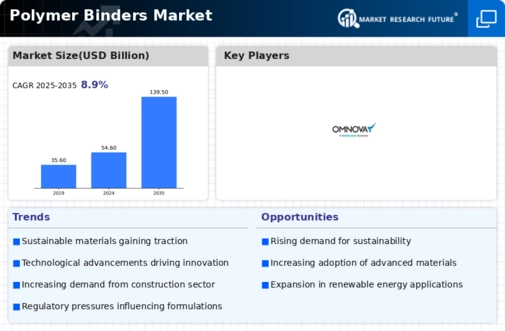Polymer Binders Size
Polymer Binders Market Growth Projections and Opportunities
The Polymer Binders Market is influenced by a variety of factors that collectively shape its trends and growth dynamics. One key driver is the increasing demand for polymer binders in various industries, including construction, paints and coatings, adhesives, and textiles. Polymer binders, which include latex, acrylics, and vinyl acetate ethylene (VAE), play a crucial role in providing adhesion, cohesion, and durability to a wide range of products. As these industries continue to grow and evolve, the demand for high-performance polymer binders rises.
Polymer Binders Market is projected to be worth USD 54.6 billion by 2030, registering a CAGR of 8.9% during the forecast period (2021 - 2030).
Global economic conditions play a pivotal role in the Polymer Binders Market. Economic growth and urbanization contribute to increased construction activities, infrastructure development, and manufacturing processes, fostering the need for polymer binders. Developing economies, experiencing rapid industrial expansion and construction boom, significantly drive the market's growth as they become key players in the global manufacturing landscape.
Technological advancements in polymer binder formulations impact the market dynamics. Ongoing research and development efforts lead to innovations that enhance the performance, versatility, and environmental sustainability of polymer binders. Companies that invest in these technological advancements gain a competitive edge by offering binders with improved properties, such as low VOC (volatile organic compound) content, better water resistance, and enhanced durability.
Environmental considerations and regulations are critical factors in the Polymer Binders Market. With an increasing focus on sustainable and eco-friendly products, the demand for polymer binders that align with stringent environmental standards grows. Companies in the market are compelled to develop and offer binders that are environmentally friendly, low in toxicity, and comply with regulatory requirements, thereby catering to the preferences of environmentally conscious consumers.
Geopolitical factors and trade dynamics play a role in shaping the Polymer Binders Market. Fluctuations in trade relations, changes in tariffs, and geopolitical tensions can impact the supply chain and pricing of polymer binders. Companies in the market need to stay informed about global trade developments and adjust their strategies to navigate potential risks and capitalize on emerging opportunities in the global market.
Moreover, the construction industry significantly contributes to the demand for polymer binders. As construction projects become more sophisticated, the need for binders in various applications, such as mortar, tile adhesives, and renders, grows. Polymer binders enhance the strength, flexibility, and durability of construction materials, making them indispensable in modern construction practices.
The paints and coatings sector is another key driver of the Polymer Binders Market. Polymer binders are essential components in paint formulations, contributing to adhesion, color retention, and film formation. With the growing demand for high-quality and long-lasting coatings in residential, commercial, and industrial applications, the demand for polymer binders in the paints and coatings industry continues to rise.
Raw material prices, particularly those of monomers used in polymer binder production, play a role in shaping the Polymer Binders Market. Fluctuations in the costs of these raw materials impact the production costs and pricing of polymer binders. Companies in the market must implement effective supply chain strategies and cost management practices to navigate these raw material price dynamics.





Leave a Comment